Please Subscribe, Like, Comment, And Donate! Next Episode March 18. 2017. Stay Tuned For Bloopers From
Please subscribe, like, comment, and donate! Next episode March 18. 2017. Stay tuned for Bloopers from this episode on March 11, 2017. Starring: Candice Lola Directed by Rebecca Berger Produced by Rebecca Berger and Candice Lola Written by Candice Lola Editing, Color, Sound Design by Rebecca Berger Animation by Rachael K McDonald Links: Music: http://ift.tt/1JICaNj and http://ift.tt/2lquxdO http://ift.tt/2lINlQJ http://ift.tt/2lqtjzr http://ift.tt/2lIL08B http://ift.tt/2lqvuCQ (Donations are always welcome!) http://ift.tt/2lITyw7 http://ift.tt/2lqvQJO
More Posts from Drunkscience4u and Others
Please subscribe, like, comment, and donate! Stay tuned for Bloopers from this episode on April 22, 2017. This was the last episode of this season. Keep an eye out on the facebook page for more information on Season 2. Please comment below for any experiments or simple science you'd like us to explain while drunk! Starring: Candice Lola Directed by Rebecca Berger Produced by Rebecca Berger and Candice Lola Written by Candice Lola Editing, Color, Sound Design by Rebecca Berger Animation by Rachael K McDonald Links: Music: http://ift.tt/1JICaNj and http://ift.tt/2lquxdO http://ift.tt/2lINlQJ http://ift.tt/2lqtjzr http://ift.tt/2lIL08B http://ift.tt/2lqvuCQ (Donations are always welcome!) http://ift.tt/2lITyw7 http://ift.tt/2lqvQJO

Researchers have designed a new material that could completely revolutionize the way oil spills are cleaned up.
When the Deepwater Horizon spill happened in 2010, the cleanup presented an unexpected challenge. Millions of gallons of oil didn’t collect on the surface, where it could be skimmed off or burned, but instead was drifting through the ocean below the waves.
Scientists at the U.S. Department of Energy’s Argonne National Lab have invented a material that could prevent a similar situation in future spills.
The foam, called Oleo Sponge, can soak up 90 times its own weight in oil before it needs to be wrung out to be reused — and the oil can be recovered.
Continue Reading.

Bumblebees mark the flowers they’ve visited with smelly footprints, and they can tell the difference between odors from family members’ feet and those of strangers, researchers have found.
By sniffing out these dainty footprints, bumblebees can locate good food and steer clear of flowers whose nutrients have been depleted, the scientists reported in a new study.
“Bumblebees secrete a substance whenever they touch their feet to a surface, much like us leaving fingerprints on whatever we touch,” Richard Pearce, a scientist at the University of Bristol in the United Kingdom, said in a statement.
Continue Reading.
Please subscribe, like, comment, and donate! Next episode April 1, 2017. Stay tuned for Bloopers from this episode on March 25 , 2017. Starring: Candice Lola Directed by Rebecca Berger Produced by Rebecca Berger and Candice Lola Written by Candice Lola Editing, Color, Sound Design by Rebecca Berger Animation by Rachael K McDonald Links: Music: http://ift.tt/1JICaNj and http://ift.tt/2lquxdO http://ift.tt/2lINlQJ http://ift.tt/2lqtjzr http://ift.tt/2lIL08B http://ift.tt/2lqvuCQ (Donations are always welcome!) http://ift.tt/2lITyw7 http://ift.tt/2lqvQJO
Flying to New Heights With the Magnetospheric Multiscale Mission
A mission studying Earth’s magnetic field by flying four identical spacecraft is headed into new territory.

The Magnetospheric Multiscale mission, or MMS, has been studying the magnetic field on the side of Earth facing the sun, the day side – but now we’re focusing on something else. On February 9, MMS started the three-month-long process of shifting to a new orbit.

One key thing MMS studies is magnetic reconnection – a process that occurs when magnetic fields collide and re-align explosively into new positions. The new orbit will allow MMS to study reconnection on the night side of the Earth, farther from the sun.

Magnetic reconnection on the night side of Earth is thought to be responsible for causing the northern and southern lights.

To study the interesting regions of Earth’s magnetic field on the night side, the four MMS spacecraft are being boosted into an orbit that takes them farther from Earth than ever before. Once it reaches its final orbit, MMS will shatter its previous Guinness World Record for highest altitude fix of a GPS.
To save on fuel, the orbit is slowly adjusted over many weeks. The boost to take each spacecraft to its final orbit will happen during the first week of April.

On April 19, each spacecraft will be boosted again to raise its closest approach to Earth, called perigee. Without this step, the spacecraft would be way too close for comfort – and would actually reenter Earth’s atmosphere next winter!

The four MMS spacecraft usually fly really close together – only four miles between them – in a special pyramid formation called a tetrahedral, which allows us to examine the magnetic environment in three dimensions.

But during orbit adjustments, the pyramid shape is broken up to make sure the spacecraft have plenty of room to maneuver. Once MMS reaches its new orbit in May, the spacecraft will be realigned into their tetrahedral formation and ready to do more 3D magnetic science.

Learn more about MMS and find out what it’s like to fly a spacecraft.



Time for another comic on our reddish dwarf planet, Makemake!
(Polaris is pushed for tomorrow ;) )
http://www.space.com/23122-makemake.html
-
 final-girl-lorde reblogged this · 8 years ago
final-girl-lorde reblogged this · 8 years ago -
 final-girl-lorde liked this · 8 years ago
final-girl-lorde liked this · 8 years ago -
 southwaffles reblogged this · 8 years ago
southwaffles reblogged this · 8 years ago -
 doggytail-duck reblogged this · 8 years ago
doggytail-duck reblogged this · 8 years ago -
 shurikenship reblogged this · 8 years ago
shurikenship reblogged this · 8 years ago -
 thejusticethatissocial reblogged this · 8 years ago
thejusticethatissocial reblogged this · 8 years ago -
 not-thesheriffssecretpolice reblogged this · 8 years ago
not-thesheriffssecretpolice reblogged this · 8 years ago -
 lordrebeccasama reblogged this · 8 years ago
lordrebeccasama reblogged this · 8 years ago -
 drunkscience4u reblogged this · 8 years ago
drunkscience4u reblogged this · 8 years ago
The official page of Drunk Science! An enthusiastic host performs simple experiments and then humorously explains the science behind the result, all while visibly drunk.
126 posts
